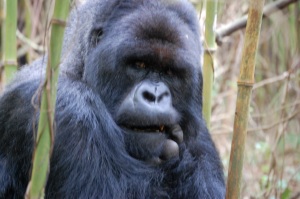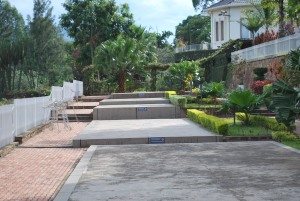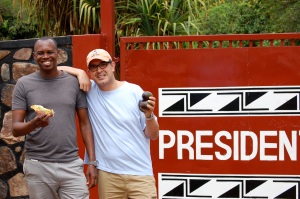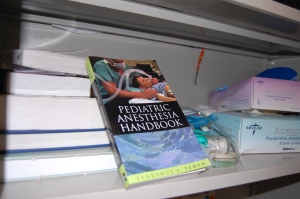Un mois, c’est vite passe et déjà finit..je me souviens du premier jour ou l’on avait pose pied sur le sol Rwandais, une nuit chaude et humide.. Kigali une ville vibrante, la lumière des maisons allume la splendeur du mont Kigali comme un collier riche de diamants étincelant la beauté defiante de cette cite. Depuis, la mission d’éducation médicale en anesthésie et l’aventure touristique commença !!!!! Des marches a pied quotidiennes, des randonnées “de collines”, des visites d’endroits splendides, le parc d’Akagera, la rencontre avec les gorilles,de la verdure a perte de vue de Nuyangwe , les plantations de thé, sans oublier la modestie, l’amabilité et la simplicité du peuple Rwandais..un aspect de la vie bien perdue par d’autres. Aux adorable écoliers de Kigali et leurs uniformes a couleur vibrante et forte ajoute un grain de mémoire inoubliable. Ces écoliers sont et seront le future du Rwanda et déjà l’hospitalité rayonne, Des “good morning” par ci et des “bonjours” par la et des sourires a en perdre la tête. Un jour un enfant commença a marcher avec nous, il était 6:45 du matin, l’air était frais, l’enfant habille en short et en pull bleu a col “V”, une chemise blanche en dessous; seulement les plus grands porte une cravate pour aller au lycée; un cartable au dos et me récita ses prouesses en langue anglaise. J’en était bien étonné mais aussi ému par cette expérience, aussi un aspect de la vie perdue par d’autres, il avait 8 ans. Des expériences comme celle ci y’en a avait des tonnes.. des enfants et grands aussi jonchant les routes vous saluent de la main, vous lancent des YAMUNZUNGO ( un voyageur) et des AGATCHOUPAS (une bouteille d’eau). Les enfants aiment demander les petites bouteille d’eau pour les remplir d’eau et les emmener avec eux pour boire durant leur long trajet a l’école. C’est commun a ceux qui vivent dans les zones rurales. Demain, je vais rentrer chez moi, retrouver ma famille et cela me fait tellement réjouir mais derrière moi je laisse une autre famille toute nouvelle, toute différente et cela m’attriste et me laisse un gout amer. Bien que l’on ai eu une mission inoubliable et fructueuse, un sentiment de l’inachevé me gagna, quelque chose me disait que ce n’était pas encore finit…et qu’il y reste tant a faire. c’est pour cela que ce n’est qu’un au revoir !!!!
Last week
We have just returned from Butare, where we have spent the past two days. We were able to bring the ultrasound, and with the help of some bupivacaine, taught the residents and anesthesia techs how to do an ultra-sound guided supraclavicular block. They really seem interested in having this and other regional techniques at their disposal, and I very much hope that eventually an ultrasound can be acquired for their permanent use. On another note, on wednesday, there was no oxygen in the pipeline when we arrived at the hospital, so no general anesthetics were administered. Oh well, spinals only!
While in Butare, we decided to partake in the “best ice cream in Rwanda”, per Emmy. Inzozi Nziza was the name of the place. It was actually pretty good! Although, my strawberry ice cream didn’t really taste like strawberry, but whatever. It turns out, the ice cream place is actually the only ice cream parlor in the nation. And, it’s also a non-profit called Blue Marble Dreams, which is awesome.
Now it’s time to start packing. Hard to believe our time in Rwanda is almost at a close.
Butare
The latter part of last week was spent at CHUB, or Butare’s University hospital. Smaller than CHUK (only 4 operating rooms), but a good place to teach. Mohamed and I had a great time teaching the three residents who are on rotation at that site. It seems the cases were a bit simpler, with orthopedics, general surgery, and OB/gyn being the bulk of the case load. The anesthesia techs and students were also very interested in learning while we were there. Mohamed even got to teach about and fashion his own cardboard L-device to hold the anesthetic circuit.
Best of all, we were able to do……..regional anesthesia! We had left the U/S in Kigali, but no worries, because we performed 3 blocks with the nerve stimulator, and a fascia iliaca block via loss of resistance, all of which were great. The residents and anesthesia techs were very interested in observing these techniques; it seems we had no less than 6 people observing placement of the blocks! The patients were quite satisfied with their postoperative analgesia. Side note: it is amazing how much longer a nerve stimulator technique takes when we are so accustomed to ultrasound-guided techniques.
Another side note: on numerous occasions, we have been left without electricity either just prior to eating or during dinner. Either at home or restaurants, it doesn’t matter. electricity is not really the most dependable of utilities in Rwanda. So after it happened again in Butare we decided just to photographically memorialize the events or, how we have come to describe the experience, an ongoing bromance marked by candle-lit dinners. At the present time, however, our slow internet isn’t permitting picture uploads. To be added later.
After two days in Butare, we set off for Nyungwe National Park. I’ll let Mo talk about that in more detail, but it was a good relaxing time. Now we are back in Kigali, with one more week of work ahead of us!
Mortality
Over the past three weeks, we have sadly heard of five perioperative mortalities. Although I have not been directly involved with any of these cases here, the thought of a patient not surviving surgery unnerves me. I think we all know that a perioperative death, while always a possibility, is not common at our home institutions; certainly not in the operating room. When one does happen under our watch, it takes a while to recover from the experience. One can’t just roll into the next case; some decompression time is needed. Yet the residents here have all for the most part been involved with at least one perioperative death. They understand that in this setting sometimes negative outcomes happen, and sometimes that negative outcome is perioperative demise. I still have a difficult time with the thought of one of my patients not surviving a surgery, as I’m sure most of my US counterparts also do with regards to their patients.
Sometimes there is nothing you can do. A 14-hour postpartum hemorrhage patient with a Hb of 3.5 and in likely DIC at presentation. An infant with massive sepsis who develops bradycardia unresponsive to atropine and epi. These types of cases are heart-wrenching. Then there are also the ones where things possibly could have gone differently. Maybe if the CT scanner were working; perhaps if a compartment syndrome had been recognized earlier at the rural health center; possibly if a different dose of a medication or a different, currently unavailable, medication could have been used upon arrival to the hospital.
At other times, some near-misses have been witnessed. Usually it is no specific person’s fault. Partly, it is a systems issue or a procurement/equipment problem. Lack of communication among departments, help, blood, supplies, etc. We all work with what we have. Unfortunately what we have in developing countries sometimes is not enough. But sometimes there is a distinct action or decision that could have been taken that could have changed outcome. Once the dust settles, these actions and decisions are there for us to analyze in hindsight so that we may learn from experience. It is our duty to learn from these types of experiences. In this regard, I think the correct steps are being taken here. First, education is paramount, and a strong emphasis exists on improving anesthetic training in Rwanda. I truly and humbly hope we are helping on that front. Second, the system is changing to facilitate patient care, albeit more slowly than one would hope. Third, possibly dangerous situations that should be avoided if at all possible are being increasingly recognized and proper action taken. Prevention is key. If life-threatening events do occur, they must be recognized quickly, and acted upon even faster. As anesthesiologists and residents we need to constantly be vigilant, both of the patient and of the perioperative environment. We need to know what to do in case X happens, how to do it, and have backup plans. I believe these points are applicable globally no matter what the operative setting.
We should always be learning; we should always be reading. We cannot afford to say “that’s good enough”, regarding either our knowledge base or patient care. No should ever be able to say that our job is boring, inactive, or intellectually non-stimulating.
The lessons are there for us, whether Rwandan or American, to learn.
Gorillas…
Ah!!!! Gorillas!! Gorillas!! The volcanoes national park visit of our genetically closest relatives was excitingly incomparable adventure. Gorillas… they are just majesties in the midst of the jungle. The Susa family, the largest group is just an example of a family living in the wild. The head of the family, a silver back is just impressive, that guy was massive; I can assure you that none of the other male gorilla could measure to him. Around, his progeny playing and fooling about, some younger climbs on the lianas, others, on the back of their elders….
Truly, the climb was awesomely challenging. Although my heart was beating at 140, the views were just amazing. Every 200 meters up, the view was becoming more and more picturesque, to a point were you are at the same horizontal line as the tallest mountain you are seeing and only then you realize how high you are at. After this amazing journey, we set way to lake Kivu for relaxation time. Another beautifully nested community-bordering Congo. Crossing the border to hike the dormant yet larvalicious volcano would have been a bonus. Back to Kigali, I was faced by the most challenging, pressure production situation I have ever been associated with, not awesomely so!!!!! I was delegated to care for a pregnant women S/P mitral valve repair 15 years prior but now non functioning (porcine graft) she missed her opportunity to replace it because of this pregnancy. She is at 29 weeks NYHA IV a BP 80/45 and on A-fib (HR 100-130) you can see the picture. With as little as an SPO2, two BP cuff to simulate an A-line, I can tell you she is still alive. At the end of the day, when Albert and I wanted to visit the Ethiopian place, we called Eugene; he is our taxi driver when we need him. Anyway on our way to eat, he is mumbling to us that he needed to go home, something about his Madame… really did not understand until the fact. We stop by the hospital, and there is these two women hoping in the car. I glance at Albert who is now being squeezed by these two ladies to the far corner of the car and we started laughing…. The food was good. And yes LDC; if you read this blog, I can tell you that the food was delicious and there was plenty :)))))
Developments
These past few days have been full of developments.
First off, in the classroom, it seems the residents are progressing well in terms of knowledge and application. Today, after the usual monday lectures, we decided to make the academic day more interesting by having a jeopardy session. Luckily, it was well-received! We had both regional and OB questions, some of which were quite challenging and would leave CA3’s (myself included) hesitating to vocalize a coherent answer. After a competitive battle, Isaac’s team came out on top.
Second, we have started teaching at the Kigali Health Institute. The anesthesia tech students seem quite eager to learn, and after an airway skills lab, they asked if we could come back to teach cardiac and pulmonary physiology this week. Sure! We have also started running through brief clinical scenarios with the anesthesia techs at CHUK. They seem to enjoy it. A peds review last week, tomorrow will be a review of thoracic anesthesia. Despite limited resources and lack of lung isolation techniques other than intentionally right-main-stemming the endotracheal tube, the CHUK team does face thoracic cases from time to time. So hopefully this will be useful for their practice.
Third, we helped Julia (HRH staff) with a cardiac physiology lecture for the residents on Friday. The lecture was teleconferenced to Butare, which made it very efficient for learning.

Last, we finally made it to see the gorillas! We were lucky enough to be assigned to the Suza group, which is the largest group in Volcanoes National Park. So, the two of us and four other adventurers set off on a hike led by a park ranger. And, let me tell you, it was not for the faint of heart. I estimate a vertical climb of about 1000 meters, which took over an hour. When we arrived at the edge of the forest, I was totally soaked from sweat. Luckily, the gorilla group was only about 30 min into the forest. Quite possibly the most amazing wildlife experience I have had. The pictures don’t do it justice (and I’m sure Mo will add more). After about an hour with the gorillas, we hiked down the mountain and headed for Gisenyi on the shores of Lake Kivu. Great time there.
Akagera bis
Driving for 8 hours in the Akagera national park was a journey. Miles of wilderness keep you breathless. From hills, down to valleys unveiling big and small lakes giving off to mountains, all in a picturesque assemblage. Crocodiles, baboons, buffalos, giraffes, impalas, zebras make it lively. It is not a zoo it is “something” of another dimension. At the lodge where we spend the night, the view from up top is just phenomenal [see photo]. On our way to the top, the two largest huts nearing each other looked from far like a giant pair of boobs according to Emmy, our driver. I think that after 8 hours of driving in the heat, even the most adept of the guides will succumb to mirages. It reminded me of St Exupery’s book, “Terres des hommes”, his story happened in the Sahara while working for the aeropostale delivering mail to North Africa. Spending much time in the desert after his plane crashed, his senses started to trump him while the effects of dehydration made him see oases where there was none. The road back to Kigali was less arduous than going through the park where at times your guts made it up and down again and again. We stopped by some road market, bought veggies and papaya [this one was succulent]. The Juvenal [former president] palace was well conserved since 1994 following his plane crash in his backyard. There are still remains of the plane for the visitors to see. For my self I made sure I got out with some presidential avocados [see picture below]. There was something special about them, it is not everyday that you have presidential avocados. Then came the genocide memorial [photo], atrocious and wicked. In this memorial lay the bodies of 250000 Kigalis [children, women and men] the killing lasted 100 days, which comes to 2500 death per day in Kigali only. Now you add the 500000 to 750000 throughout the country and your mind freezes. Literally!! It freezes; you cannot fathom the reality.
Monday, back to teaching, it is academic day…on Tuesday I met Dr Jean Bosco. Jean is a family practionner who practices surgery on some of his patients. It happened that Jean did his medicine in Algeria followed by a residency in Belgium. So we had a long discussion about Algeria, his experiences and talked about the good and bad times. We talked about the assassination of the president; the bombing of the Algiers airport and his goal to return to Algeria. When we approached the matter of genocide he had that sigh in his face, sadness!!! He told me that he has 50 orphans all members of his family. A young talent, Fidele, walked in and joins the discussion. He also did his medical school in Algeria and now is applying for a residency in neurosurgery. While doing his clinical rotations, his attending happened to be my sister in law who is a practicing oncologist in Algeria. Small world, huh!!!!. Albert and I are getting ready for the gorillas!!!!!
Akagera

This past weekend we went to Akagera National Park, in the eastern province. The park is bordered on the east by Tanzania, and runs approximately 180km north to south, if I remember correctly.


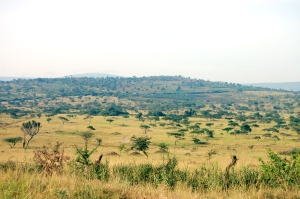

It really was a great place to visit.
We had the opportunity to observe various species of birds, mammals, and flora. Our tour guide Emmy was fantastic. Soon after our arrival into the northern part of the park, we were greeted by zebras, gazelles (4 types), water bufallo, steers, eagles, and giraffes. Pretty good turnout! As the day progressed it got to be pretty hot, but we were still able to come across hippos (with a baby hippo!) and wild boars.
After an overnight at a park lodge, we set out back to Kigali, visiting the presidential museum and the genocide memorial. At the presidential museum’s back yard Mohamed made sure to pick up some “presidential avocados”, from which we made a tasty tomato avocado salad. When we returned to the apartment, we discovered that the electricity had run out. Luckily we had been told how to go about purchasing more, so there was not much delay in getting power again, but we really were surprised how quickly one can run through electricity even with just laptops and lights running.
Long day of teaching today, 4 lectures in all, but they all went well. Later this week we will be having a journal club with the residents, which is exciting.
I know what you did with the skeleton in the ready room……..
Finding TAY book on pediatric anesthesia in Kigali…was priceless.. I wondered why they were so adept at pediatric anesthesia.. hum !!! just a thought.. you guys in the ready room made my day… Susie and Catherine you rock !!!

Adaptation
I think acclimatization has finally been achieved. No more dyspnea after the 25 minute walk to or from the hospital. One underestimates how high up we really are here in Kigali, and the stress of the hills and the heat can really take it out of you by the middle of the afternoon.
Over the course of this first week, we have already seen some interesting cases. One was a middle-aged woman with a stab wound to the chest, deep enough so that one could see mediastinum and lung move as the patient exhaled. The patient was stable enough so that the case could be done approximately 20 hours after initial presentation, with surgical management in the OR consisting of chest tube placement and wound washout and closure. On the OB side, Mohamed helped manage a patient who required a hysterectomy and had a presenting hemoglobin of 4.
As a resident, I think it is important to realize and accept that there are other ways of doing things besides those with which we are familiar during training. If there’s one thing that I have come to appreciate this week, it’s flexibility in anesthetic planning. Sometimes some catheters, monitoring equipment, or medications just are not available. One must adapt. For example, all the Datex-Ohmeda anesthesia machines were being utilized, so an unplanned GA had to rely on manual ventilation with thiopental pushes, then a Glostavent. This was my first exposure to this delivery mechanism.; I must say I was impressed. Another example: for a prone case, there’s no such thing as a “prone-view pillow”, so one must be fashioned out of rolled up blankets and towels. The Rwandan residents and anesthesia techs are quite adept at making things work.
Glostavent
Newer model Glostavent, being used in a PACU patient. The compatible vaporizers can hold halothane, thus also enabling delivery of isoflurane.
We had another morning report today, with a great review of the issues associated with blood loss/conservation in a limited resource setting. Afterwards, I went to the OR while Mo helped with final exams for some senior residents.
In the staff locker, we find a copy of Dr. Yemen’s Pediatric Anesthesia Handbook!
As it is Friday, the OR wrapped up earlier than usual. I decided to head out to explore the neighborhood around the hospital while Mohamed finished his examination. 30 min later I stumbled upon Hotel de Mille Collines, or the hotel in the film Hotel Rwanda.
View from balcony of Mille Collines.
Tomorrow we set off for Akagera National Park for a short respite.






